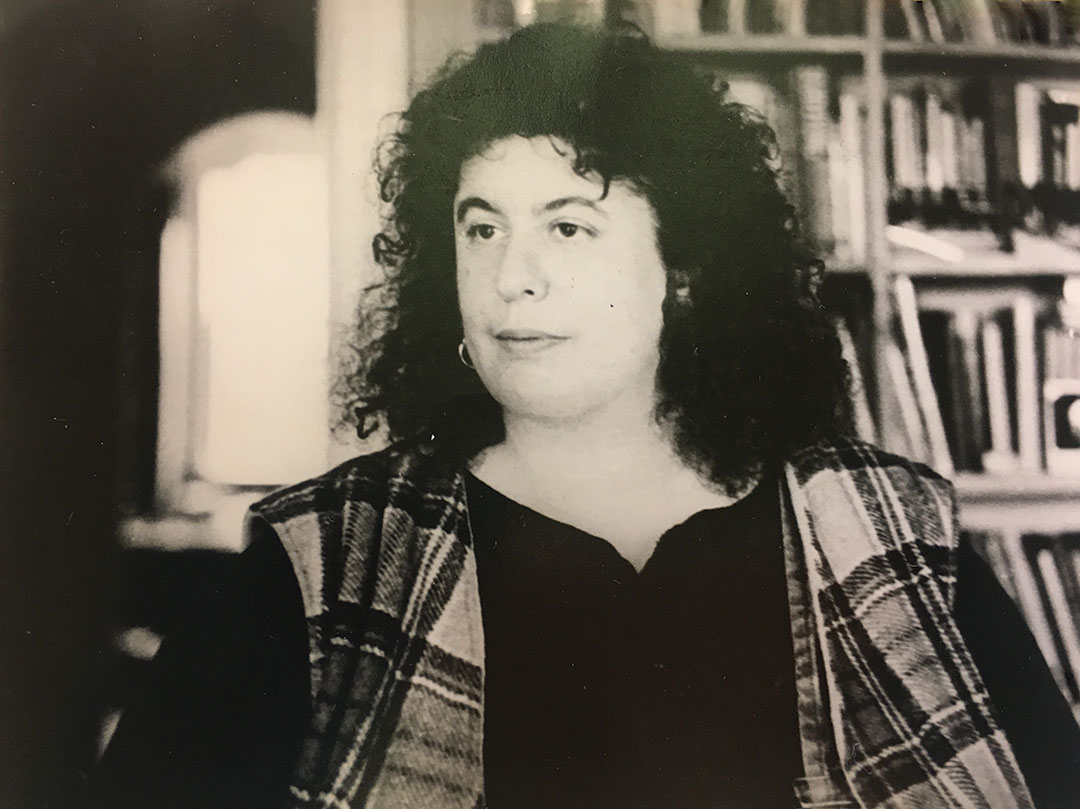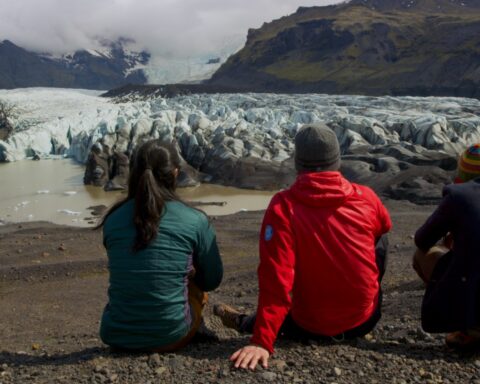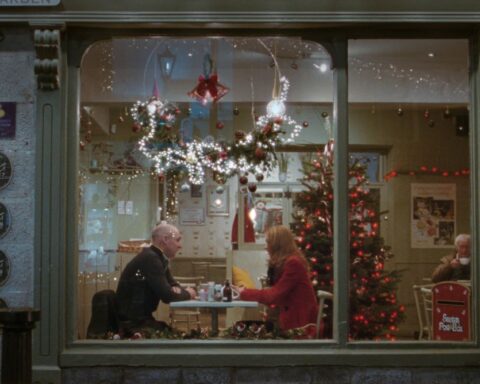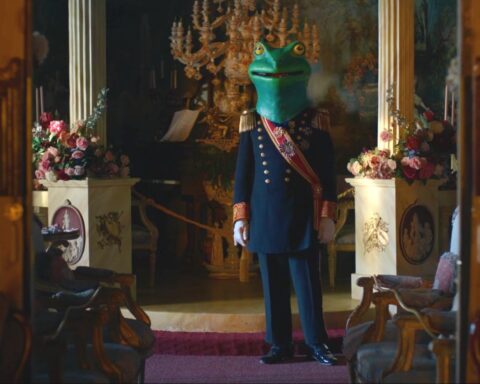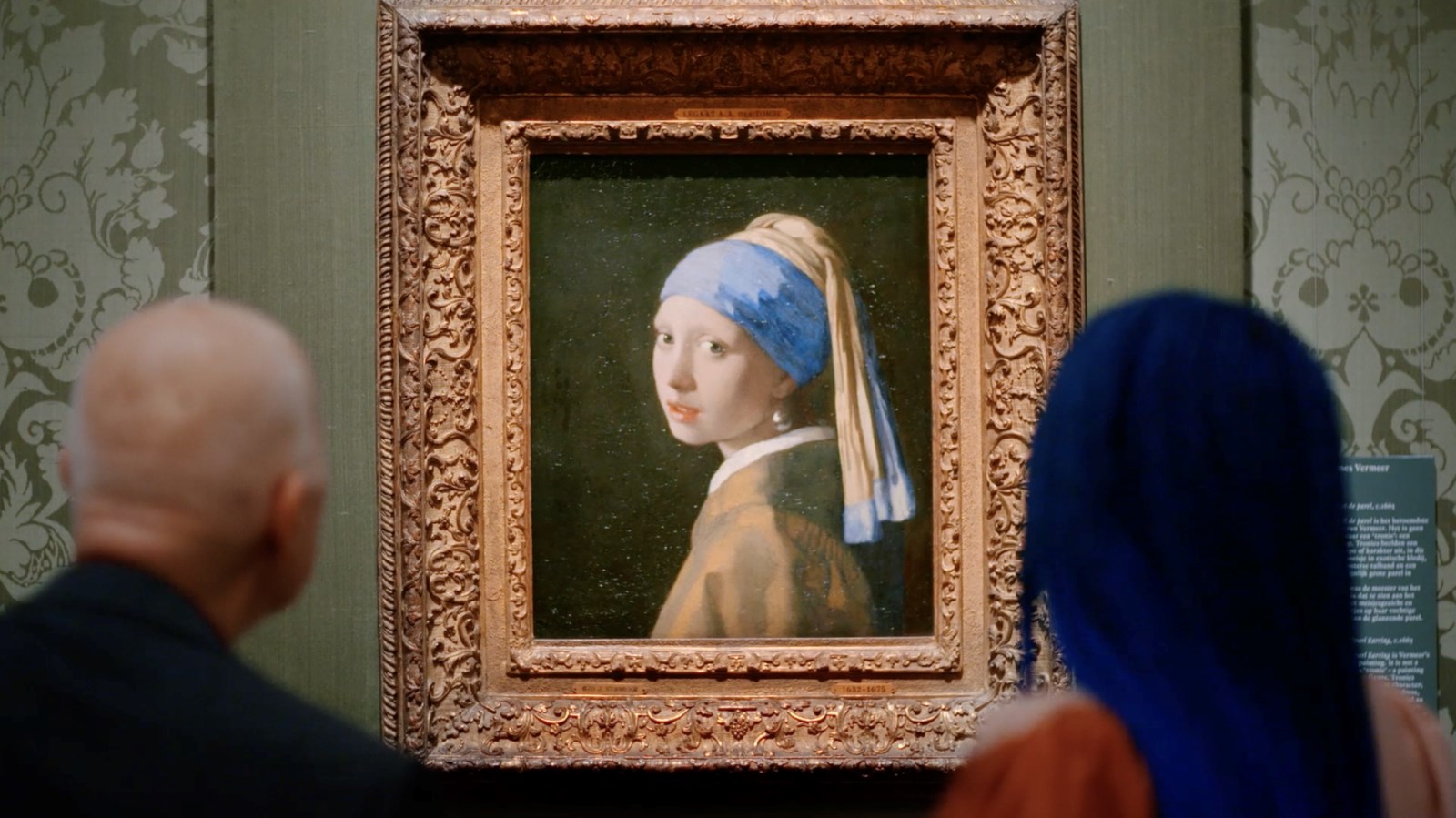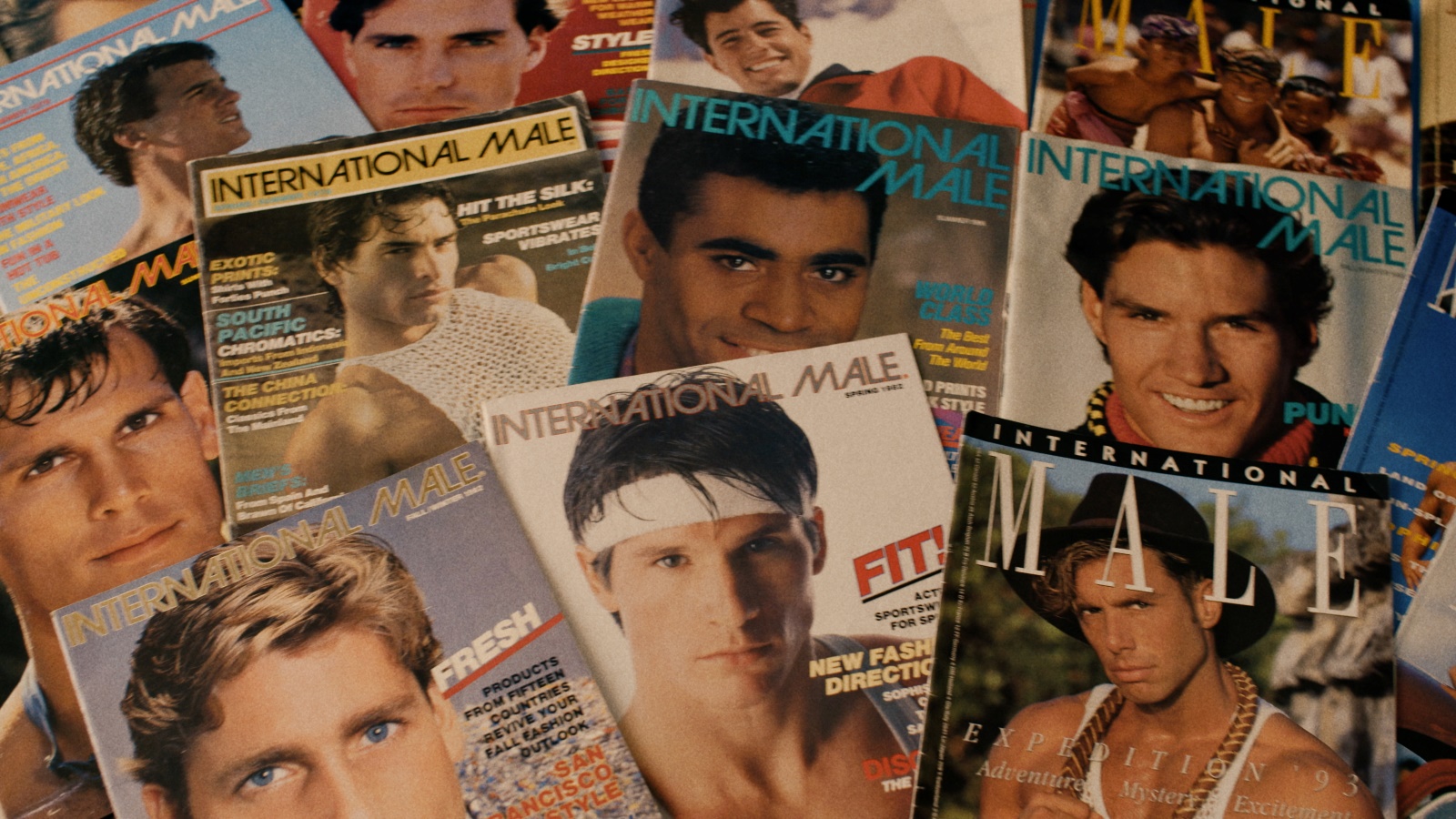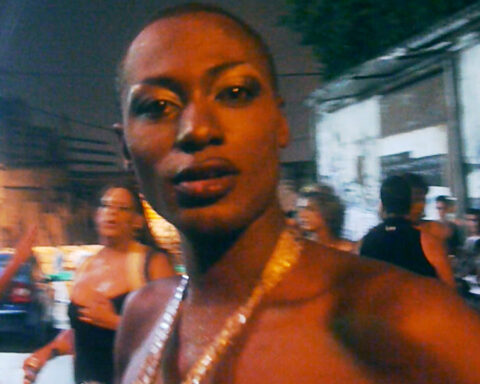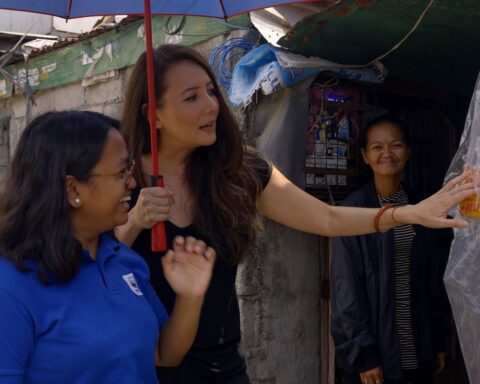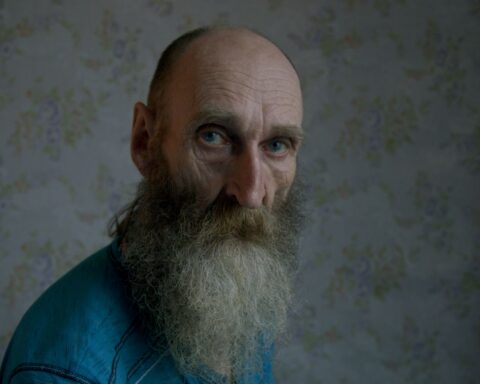Alexandra (Alex) Juhasz, feminist and queer videomaker and scholar, reached out to Pratibha Parmar, queer British filmmaker of colour, after the premier of her documentary, My Name Is Andrea, at the Tribeca Film Festival in NYC in July 2022. Juhasz was curious to better understand a host of formal choices that Parmar had unrolled in the feature documentary, which occurred perhaps, because of the controversial figure under question, or the many silences and violences of Andrea Dworkin’s story. Over an hour of conversation led to more thinking and back and forth about the limits of non-fiction, factions within feminism, and the feminist production of discursive disturbance.
About half of this conversation was published online at MS magazine in October, “I’m This. I’m That. I’m Many Things,” focusing on “inter-related concerns of voice, silence, ‘maleness,’ and intra-feminist strife and legacy” in the documentary. This excerpt for POV attends more to questions of documentary form and its poetical and political textures. The film screens at the Toronto Jewish Film Festival, on June 7, 2023.—Alexandra Juhasz
AJ: Alexandra Juhasz
PP: Pratibha Parmar
AJ: Pratibha, in My Name Is Andrea, Andrea Dworkin is introduced to me—someone who only knew the verboten writings on pornography—as an extraordinarily eloquent, deeply political, powerful cultural-, speaking-, and writing-force. A true public intellectual. This happens as much through your assembling of her words, writing, recorded performances in public, and no less than five actresses—Amandla Stenberg, Soko, Christine Lahti, Ashley Judd, Andrea Riseborough—playing her across the span of her life, as it does through the complex filmic form you engineer to break from the biopic or hagiography.
PP: I am genre agnostic. I have always been interested in testing the limits of non-fiction and fiction so as to see what happens when you juxtapose beauty with terror, when you break the fourth wall and, say in this case, the victim of sexual assault confronts the audience’s gaze, turning them into active participants rather than passive objects.
I wanted to reach into the crevices of visual poetical textures that could startle… [I wanted audiences to] Look, listen, sit up and think about what the war on women does to us, to our bodies, to our psyches, to our potential to be fully human in this misogynist world. Dworkin’s words and life enabled my own creative political exploration.
I wanted to explore approaches to documentary that might depict Andrea’s visceral experience and the interiority of the trauma of sexual abuse as captured in her words, so that those words and those emotions would seep through the frame to resonate for anyone who has experienced sexual abuse/violation.
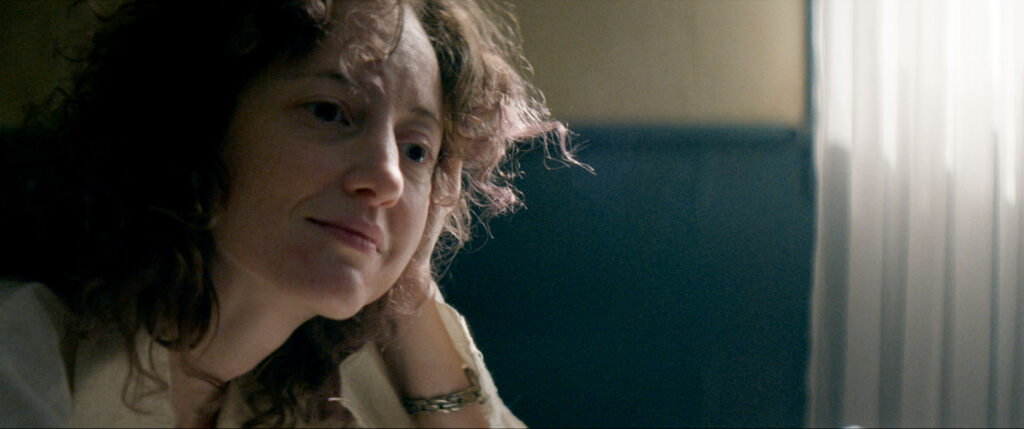
AJ: Your commitments to using documentary film to depict the inner state of a feminist warrior and writer helps me to understand why yours is no simple biopic, no falling into (or hiding behind) expected formats so as to unroll one person’s powerful history in a familiar format. There’s a lot of notable film between you and us and Andrea Dworkin: reenactment, elegant cinematography, images of present-day and historical feminist activism, the weaving of her actual voice reading her own words and also her prose as read by actresses.
PP: From the get-go, I eschewed the biopic trope, curating Dworkin’s voice through everything that was available to me. In fact, I started by writing a screenplay only using Dworkin’s words for the five dramatizations in the film. I am orchestrating all these storytelling and archival elements into specific configurations, motifs, giving weight to some elements of the story over others.
One of the starting points in thinking through the documentary language of the film came from Dworkin’s memoir, Heartbreak—The Political Memoir of a Feminist Militant (2002), which begins with a Rimbaud quote, “Je suis un autre,” which roughly translates into “I am other.” Andrea insists on not being defined as any one thing, instead saying, “I’m this. I’m that. I am many things.” Her words enabled me to create a stylized collage of her different selves at different times in her life. There was freedom for me as an artist that she is no longer in this world. Instead, what I did have access to was written materials, her TV appearances, radio interviews, and her writing: multiple narratives and records of who and how she was formed and her life experiences. What interested me was her incisive thinking—even when I didn’t agree with it. But it was also that creatively I could approach the telling of the story in an expressionistic way, moving beyond a singular linear biography, telling multiple stories.

AJ: Your use of archival footage is one predominant method to introduce us to Dworkin in public: a powerful, larger than life, eloquent, enraged, and dynamic speaker. You largely use reenactment—Andrea played by five talented actresses in gorgeous period drama—to show us the travails of her private life and how this, too, motivated her analysis. You intimate that the sexual violence that occurred to her produces her rageful voice. In the stunning speech that you cut to quite frequently, “I Want a Twenty-Four Hour Truce During Which There Is No Rape,” she all but preaches at the 1983 Midwest Regional Conference of the National Organization for Changing Men. She says: 1. hear women and 2. stop this culture of violence. Women need to be heard and men need to stop.
PP: Indeed. She pushed against the limits of imagination and I think she was fully cognizant of what she was doing (as am I). To speak in extreme terms, not literally but metaphorically. She wanted to stop you/us so that we would read and engage with her ideas in the same way one would engage with male writers and philosophers.
When I read her book Intercourse (1987), I was surprised at her nuanced inquiry into male writers like Tolstoy, Mailer, Tennessee Williams, and others, and their use of language to describe heterosexual intercourse—in their writings men “invaded,” “possessed” women’s bodies—language that laid bare their ideas of female sexuality as being inferior or in service to men, casting women as being the space which is entered and violated. She was saying “look at how this language has been normalized and the impact of that on how women are perceived.”
AJ: Could we say that your documentary, as is true of Dworkin, un-normalizes (documentary) language? Let’s continue to think together through the words you have chosen to describe your film: beauty, terror, confrontation, crevices, poetical and perhaps political textures.
PP: These are so many constructive metaphors, especially when I think about the surprising portals that opened me to Dworkin. During my early research, I came across a quote from the European cultural critic, John Berger, who said that “Dworkin was one of the most misrepresented writers of the Western Hemisphere,” and this piqued my curiosity. Berger was a huge influence on my early political thinking, especially his 1972 series Ways of Seeing. And so his observation about Dworkin made me ask: why was she misrepresented by others? Who was she beyond the sensationalist headlines that many, including me, had got to know of her?

AJ: So: opening lines of query; altering forms and forces of representation?
PP: Exactly. Only by pursuing these lines did I later come across a quote from another cool dude, Leonard Cohen. In an interview with Rolling Stone (1989), he had Dworkin’s Intercourse on his hotel bed and when asked why he responded:
The whole range of arguments in that book is quite radical and complex and beautiful. It’s the first book I’ve read by an author, masculine or feminine, that has a defiance of the situation, which is deeply subversive in the holy sense—it’s other-worldly. She says that this world is stained by human misconception, that men and women have wrong ideas—even if they are ten million years old and come from the mouth of god, they are still wrong! The position in that book is so defiant and passionate that she creates another reality and just might be able to manifest it. It’s from that kind of appetite, with the way things are that new worlds arise, so I have deep admiration for Andrea Dworkin.
These two men made me pay close attention to Dworkin in a way I never thought I would have. That sounds kind of surprising, right, to suggest that two white dudes inspired me. [Laughs.] But I have enormous respect for Berger and Cohen as expansive thinkers and creative artists. So, there you go.
AJ: OK: let’s add expansiveness, defiance, holiness, and white men. For a documentary about a supposed “man-hating lesbian” there is a lot of maleness, and men, in your picture as well. In the film, Dworkin is often seen in conversation (or debate) with the male “geniuses” of her time; and it seems from her words quoted in your picture that she is interested in claiming or exploring this position for herself, if by that we mean the power and privilege given to white cis straight maleness but as expressed and experienced by a woman. Her work seems oriented to disruptive and also reasoned conversation and antagonism with patriarchy and patriarchs: to counter, to correct, to protect ourselves from them.
PP: Her loud, in your face provocations through her body and her writings made people mad, made people dismiss her ideas as too radical, and made many feminists want to distance themselves from her as well. Was it because they were afraid of her stark, angry vocalization of how women’s bodies were violated? I did wonder if Dworkin was the punk rock of feminism. (laughs) I know, I know … but like the punk rockers I hung around with in London in my youth; she would not be constrained or controlled. She questioned everything. I was drawn to how she refused to concede on her demand that women be seen as fully human.
AJ: Are you are suggesting that a minimizing or distorting of her position on heterosexual and queer sex was part of a larger project of sidelining her by various, and actually quite different, factions? A kind of ideological or intellectual attack to silence her loud and in-your-face public presentation? Would you characterize any of your documentary style in this film similarly?
PP: I have no idea if there was some larger project to silence her. What I am saying is that her rage, her refusal to capitulate to culturally acceptable notions of femininity and her mode of address were not comfortable for people across the board. To quote John Berger again, “she was full of fury and tenderness” and it’s that interstitial space that I was curious to explore in the film. Tell me Alex, having seen the film, would you characterize my documentary style with this film in the ways you outline in your question?

AJ: The documentary itself as some sort of in-between space between fury and tenderness? The reenactments are tender, certainly, even as they often depict extraordinary violence against her. That care for her comes across in the performance, lighting, and mise-en-scene. Fury? I’d identify that in the no-holds-barred presentation, a kind of blank address rather than an apologetic one, of someone who knows her film will infuriate many, even as she entrances others. That, and I suppose, in how you now talk about it with me!
PP: Earlier I spoke about Dworkin being unwieldy, stubborn, and refusing to compromise. These are not acceptable attributes for a woman (laughs). There seems to have been many contributing factors to her being cast as this “witch from hell” who refused to obey, who refused to make herself and her voice palatable for easier consumption. Her rhetoric of dissent was not to everyone’s taste. And she had it coming from all sides. Frankly, there are feminist critics of the film who render me invisible as a woman of colour filmmaker who is bringing a very specific intersectional lens to Dworkin’s story. I have so many thoughts about this, that I feel an update to my 1983 essay, “Challenging Imperial Feminism,” percolating. [Laughs.]
It would begin:
I constructed this cinematic space/frame to tell this particular story of Andrea Dworkin because I, Pratibha Parmar, the curious filmmaker, artist, activist, think that she has something powerful to say today: about cultures of amnesia where women go missing every day and we as societies move on; misogynist cultures which allow for daily murders, bodily violations of women’s bodies and cultures, where women’s speech is penalized for speaking out about domestic abuse.
AJ: Interestingly, because of the so-called feminist sex wars in the 1980s and 1990s (when you and I came to voice as “pro-sex,” AIDS, and queer activist mediamakers), Andrea was a powerful proponent of the “anti-sex” position. There was and continues to be both a great deal of intra-feminist debate and also silencing when it comes to her position. I for one did not read her as a developing feminist because I understood her position to be antithetical to the one I was developing within queer feminist media communities, particularly in regard to her sentiments about pornography and also sex with men. What I saw in your film was some of what rankled me at that time, but mostly the film steers toward the many other depths and through-lines of her writing and activism as a feminist: from anti-war, to anti-imperialism, anti-capitalism, and anti-racism.
PP: When I was researching and talking to people, the bitterness was palpable…the emotions about the vehement fights that went on, amongst feminists and lesbians at that time—all reduced to pro-sex and anti-sex camps. Reviewing that literature, I was very clear that this was not a debate I wanted to foreground. I couldn’t find myself in the rancor. I DID want to foreground her as a powerful writer and activist who eviscerated the impact of systemic patriarchal violence. I had a very clear intent from the get-go to not make a polemical, didactic documentary full of talking heads which laid out all sides of an argument. However, the section in the film where we get to the pornography debate is the only section which veers into this traditional doc world. I made this exception because it was important to me that the opposition to Dworkin/McKinnon Ordinance was sign-posted and given some air.
AJ: It’s interesting to me that you needed a more familiar format to air this debate, even as it is a quite small part of the larger picture. It seems to me that you have some anger about expectations placed on you about documentary, feminists’ lineage, and history making.
PP: Ha, that’s an interesting observation. I wouldn’t characterize it as anger–frustration perhaps, and even disappointment. Firstly, I know several white feminists from that time who hated Dworkin and were surprised and not too pleased that I was turning my lens onto her. To them it seemed that if a respected feminist of colour filmmaker was giving cinematic attention to Dworkin, it would legitimize her. They couldn’t see beyond that firewall. Adjacent to that trajectory was an underlying assumption that they were the adjudicators of any attention that should or should not be paid to Dworkin. This was made quite explicit in some social media and blog posts both before the film got started and posts that came flying out after the film screened at festivals. There was no attempt to even disguise the attitude of ownership of Dworkin.
You ask about the expectation placed on me re: documentary and to that I would say it was quite eye opening for me to read academic feminists, philosophers or sociologists who critiqued the film with little or scant knowledge of cinematic grammar or the film’s hybrid language. When I was working on the screenplay and the writing and rewriting that happened in the editing, my touchstone was a quote about cinematic writing from Agnès Varda, stuck on my wall: “[It].is not about illustrating a screenplay, not adopting a novel, not getting the gags of a good play, not any of this. I have fought so much since I started… for something that comes from emotion, from visual emotion, sound emotion, feeling, and finding a shape…which has to do with cinema and nothing else.”
Agnès Varda was my guide but so was the fearless poet June Jordan who I was fortunate to call family. I constantly took succor from them as this was by no means an easy film to make. And it took far too long.
I was also interested in exploring via film what Dworkin had to say about being a woman writer. She talks about how women writers are not allowed to have a “roiling heart.” They’re not allowed to have feelings that are emotionally vibrant and politically in your face. Men are geniuses for the very qualities with which women are dismissed. She was told that women are expected to deliver pretty words. One of her publishers said to her “We can’t publish this because you write like a man” to an early manuscript of Woman Hating (1974). That’s interesting for me as a feminist who’s been told that I’m too angry as a queer woman. I’ve been told that I should just be quiet about my queerness because it’s destabilizing a whole other agenda of equality. So many women have been told that our anger is unwanted, that it is not in any way creative, that it actually does us a disservice. Our rage and its articulation are seen to be irrational.

AJ: There is a form of male genius rooted in anger and fucking things up. But what is a feminist model of genius—or punk—or is that even an oxymoron?
PP: Audre Lorde talks about the power of our anger and how useful that can be. Sinéad O’Connor said she was told to shut up and sing. This patriarchal narrative of defining women’s voices, women’s rage, women’s anger, being continually beaten down, continually marginalized and misrepresented, that theme was really important to me. And that was tied into another concern: how do we as women come to speech? What is speech for women when we do find our voice? And Andrea talks about how she went mute. She couldn’t find the words to speak about what had happened to her.
What does it take to come to speech for people on the margins of culture? It was revelatory to see how her speech developed over the years in all these different registers: strident, angry, preachy, discursive, calm, and even vulnerable. It was imperative to go beyond the reductive representation of her as this angry fat Jewish woman, a lesbian man-hater.
 AJ: Perspective. Intransigence. Defiance. Risks. Staying Open. Prescience. Intersectionality. These are feminist methods of transformation and travel, close consideration and openness to change, representation and listening. Your film is not a hagiography. It’s not even a biography. It is a map of a complex developing human being, who’s very smart, and also, maybe going a little crazy along the way.
AJ: Perspective. Intransigence. Defiance. Risks. Staying Open. Prescience. Intersectionality. These are feminist methods of transformation and travel, close consideration and openness to change, representation and listening. Your film is not a hagiography. It’s not even a biography. It is a map of a complex developing human being, who’s very smart, and also, maybe going a little crazy along the way.
PP: In 1988 I wrote a piece called “Rage and Desire: Confronting Pornography” for Feminism and Censorship: The Current Debate. I went back to find it because of our conversations.
 AJ: Look at that. “What we do need is a greater sophistication in the language and analysis of pornography than has been witnessed so far.” Given the 35 years that have passed, it’s exciting to see that the sophistication you sought might be developed over time, that is a lifetime (yours but also hers) in movements.
AJ: Look at that. “What we do need is a greater sophistication in the language and analysis of pornography than has been witnessed so far.” Given the 35 years that have passed, it’s exciting to see that the sophistication you sought might be developed over time, that is a lifetime (yours but also hers) in movements.
PP: I was just coming into my lesbianism, my erotic possibilities. And I was like, “I am not having anyone tell me what I can watch and what I can read. Nobody’s censoring me.” I’m just coming out of all these censored moments in my life, the strictures of my culture and my community. And I’m a free woman and I want to be able to see and do whatever I want with whoever I want.
AJ: And 30 or more years later, no longer coming into voice, but rather a filmmaker who has honed and owns hers, how do you think your film enacts your contemporary queer feminist of colour documentary commitments?
PP: I don’t think I ever want to stop coming into voice. I am not one for stasis. I like movement of thought and hope to remain open to the creative urges that might take me in multiple directions. My contemporary feminist filmmaking commitments are not to documentary as a genre but to storytelling in innovative ways that stretch creative boundaries of narrative and non-fiction forms. And I have never been much of a conformist, so on some level I am conscious of not letting my multi-faceted identities proscribe my filmmaking intentions into narrow tunnels of expectations.
By staying open and also present-minded, there were so many discoveries that mounted up to create a wholly different picture of Dworkin than I had ever seen or expected. I found a rousing piece of writing where she explains how she was empowered by a photograph of Huey Newton where he is defiant against the police, and in this defiance, he insists on his selfhood.
She found strength in this photograph at a point in her life when she was running from an abusive husband and as yet had not come to feminism. And then there is her famous, “Take Back the Night” march speech in Los Angeles in 1980 where she makes connections between racialized and sexualized violence. I hadn’t seen much of that in white feminist literature or political discourse from that time. There were so many discoveries that mounted up to create a wholly different picture of Dworkin than I had ever seen or expected.
One of the most startling archival images of her that my producer Shaheen Haq found was a speech she gave at Cambridge University in 1992. In this speech Dworkin is talking about the construction of whiteness in America in a way that remains relevant to this day. Here she is, this large white woman with unkempt hair in overalls, speaking to young mostly white privileged youths about settler colonialism. You can hear the nervousness in her voice. This woman took risks, went to spaces where she was constantly the other. This resonated for me. If you really practice and embody your intersectionality, then you would naturally be open to Dworkin’s.
Being an outsider allows me to step back and say, “what are the links between racialized violence and sexualized violence in terms of the kind of systemic racism and misogyny within American (or any) culture?” Where are the white women who have contributed to this conversation? There’s Andrea.
Things have gotten worse. That’s something that I feel deeply passionate about, deeply invested in, in terms of cultural/political and actual physical assaults on women’s bodies, trans bodies, Black bodies, Indigenous bodies. Through her story, I wanted to speak to multiple narratives of assault and resistance.
AJ: Is that why you include contemporary footage of feminist protest, another kind of documentary break from the traditional biography, given that these images come after her death and not necessarily in relation to her words or actions?
PP: I included contemporary footage from protests in Argentina, from Spain, Brazil, and the US: women resisting on the streets, doing street performances. I also included footage from Suzanne Lacy and Leslie Labowitz-Starus, who did a powerful performance in 1977 on the streets of LA called In Mourning and In Rage: their resistance piece on rape, a powerful artists’ statement.
Ultimately, I am interested in different modes of resistance to male violence, white capitalist violence, and how art has been and continues to be necessary. There is an arc between generations of female artists’ protesting violence against women. And I want Andrea’s voice to be part of the conversation on its own terms and in its complexity.




